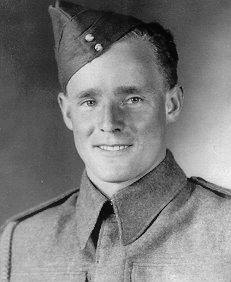Moro River
Canadian War Cemetery

copyright © Wartime Heritage Association
Website hosting courtesy of Register.com - a web.com company
Wartime Heritage
ASSOCIATION
Remembering World War II

Charles Glenwood Bower
Name:
Charles Glenwood Bower
Rank:
Trooper
Service No.:
F/5170
Service:
4th Reconnaissance (Recce) Regiment,
4th Princess Louise Dragoon Guards, RCAC
Date of Birth:
August 20, 1920
Place of Birth:
Baccaro, Shelburne Co., NS
Date of Enlistment:
April 6, 1942
Place of Enlistment:
Yarmouth, NS
Address at Enlistment:
Baccaro, Shelburne Co., NS
Age at Enlistment:
21
Trade:
Labourer; in defence work for 10 months prior to enlistment, fisherman prior
Marital Status:
Single
Religion:
United Church of Canada
Next of Kin:
Charles Bower (Father) of Baccaro, Shelburne Co., NS.
Date of Death:
January 23, 1944
Age at Death:
23
Cemetery:
Moro River Canadian War Cemetery, Italy
Plot:
VI. A. 6.
Commemorated on page 255 of the Second World War Remembrance
Displayed in the Memorial Chamber of the Peace Tower in Ottawa on May 29
Charles was the son of Charles Harvey (1884-1954) & Lucy Edna (Crowell) Bower (1894-1954), of Baccaro,
Shelburne Co., NS. He had four sisters and two brothers Vernon Lery and Gerald Carlyle. His sister Edna
May Brown lived in Yarmouth, Nova Scotia. His brother Gerald Carlyle Bower (Service No. F/57796) died
on September 15, 1944 while serving with the West Nova Scotia Regiment.
After enlistment early in 1942, he completed his basic training and Camp 60 in Yarmouth, Nova Scotia and
was in Borden before transferring overseas to England at the end of July 1942.
From England, the 4th Recce Regiment, 4th Princess Louise Dragoon Guards, joined the Sicilian and
Italian Campaigns.
After Sicily, the regiment landed at Reggio di Calabria, on the Italian mainland on September 3, 1943, on
the heels of 3rd Canadian Infantry Brigade and immediately began providing 1st Canadian Infantry
Division Headquarters with information with regard to the ground to the north including the condition of
roads and bridges and the location and strength of enemy forces.
Each of the squadrons was composed of three scout troops and assault troop, equipped with a
combination of Otter Light Reconnaissance Cars and Fox Heavy Reconnaissance Cars. The Fox had a
revolving turret fitted with a .50 calibre Browning machine gun as well as a Bren 303 calibre light
machine gun. The Otter mounted a single Bren as did the Universal Carriers used to transport the Scout
and Assault Troops.
The unit would move in advance of main forces to locate the enemy. When a reporter asked squadron
commander Major Harold Parker as to what he and his men did in Italy he replied: "We keep driving until
the enemy shoots at us. Then we know he is there".
By the winter of 1943, the German armies in Italy were defending a line stretching from the Tyrrhenian
Sea north of Naples, to the Adriatic Sea south of Ortona. The Allies prepared to break through this line to
capture Rome. For its part, the 1st Canadian Infantry Division was to cross the Moro River and take
Ortona.
In January 1944 the Canadian Corps selected the site of the Moro River Canadian War Cemetery,
intending that it would contain the graves of those who died during the Ortona battle and in the fighting
in the weeks before and after it. The Battle of Ortona ended December 28, 1943.
Charles died of multiple Mortar wounds received in combat January 23, 1944 and was original interred in
a British cemetery near Vasto, Italy, and later transferred to the Moro River Canadian War Cemetery.



- World War I - Menu
- WWI Stories and Articles
- Photos - Yarmouth Soldiers
- Selection of World War I Songs
- WWI Casualties of Yarmouth, NS
- Those Who Served - Yarmouth, NS
- WWI Casualties Digby Co. NS
- WWI Casualties Shelburne Co. NS
- Merchant Mariners (1915) Yarmouth, NS
- Canadian Forestry Corps - Non Yarmouth Birth/Residence Enlistments
- US Draft Registry - Yarmouth NS Born


- World War II - Menu
- WWII Stories and Articles
- Telegraphist Air Gunners
- WWII Casualties of Nova Scotia
- US Casualties with NS Connection
- Far East/Pacific Casualties with NS Connection
- Merchant Navy Casualties Nova Scotia
- Nova Scotia WWII Casualties Holten Canadian War Cemetery
- D-Day Casualties - Nova Scotia
- CANLOAN Program Casualties - Nova Scotia
- Battle of the Bulge Casualties - Nova Scotia
- WWII Casualties Yarmouth NS
- Yarmouth Casualties - RCAF RAF Canadian Army WWII
- Yarmouth Co., Marriages WWII
- Casualties Non-Born/Residents with Connection to Yarmouth Co., Nova Scotia.
- WWII Casualties Digby Co., NS
- Non-Nova Scotian WWII Casualties Buried in Nova Scotia
- WWII RCAF Casualties Aged 16-18
- Brothers/Sisters Who Served - World War II














